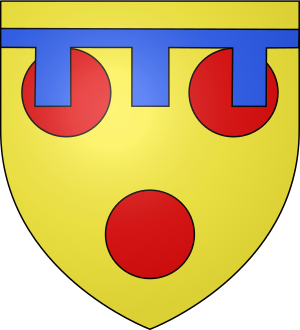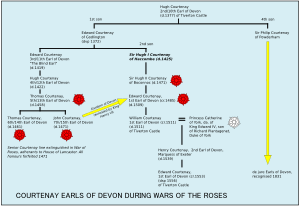Hugh Courtenay (died 1471) facts for kids
Sir Hugh Courtenay (around 1427 – 6 May 1471) was an important person from Boconnoc in Cornwall, England. He served as a Member of Parliament (MP) for Cornwall twice, in 1446–47 and again in 1449–50. He was executed after the Battle of Tewkesbury in 1471. This battle was a key event in the Wars of the Roses, a long conflict over who should be King of England. His son, Edward Courtenay, later became the Earl of Devon in 1485, after King Henry VII won the Battle of Bosworth and ended the Wars of the Roses.
Contents
Family Background
Sir Hugh Courtenay was the second son of another Sir Hugh Courtenay (who lived from about 1358 to 1425). His father was also an MP and a Sheriff of Devon. The Courtenay family was very old and important, connected to the Earls of Devon. Sir Hugh's mother was Maud Beaumont (who died in 1467). Her family came from Shirwell in Devon.
Fighting at Tewkesbury
The Battle of Tewkesbury took place on May 4, 1471. Sir Hugh Courtenay fought for the Lancastrian side in this battle. The Lancastrians were trying to put King Henry VI back on the throne.
Queen Margaret, King Henry VI's wife, and her son, Prince Edward, landed in England and gathered their supporters. Sir Hugh Courtenay joined them, along with other important figures like Edmund, Earl of Somerset, and John, Earl of Devonshire. They marched with the Queen's army to Tewkesbury.
The battle was very fierce. The Lancastrian army, including Prince Edward's forces, was defeated. Many soldiers and leaders were killed or captured. Some, like the Duke of Somerset, tried to find safety in Tewkesbury Church. Sir Hugh Courtenay was killed during this time, either in the battle itself or shortly after. He was likely buried at Tewkesbury.
Marriage and Children
Sir Hugh Courtenay married Margaret Carminow. She was one of the daughters and heirs of Thomas Carminow of Boconnoc. Together, they had several children:
Sons
- Edward Courtenay (died 1509): He became the Earl of Devon in 1485. This title had been held by his ancestors but was lost during the Wars of the Roses. Edward's great-grandson, also named Edward Courtenay (died 1556), was the last of the medieval Courtenay Earls of Devon.
- Sir Walter Courtenay: He died without having any children.
- John Courtenay (died 1509): He also died without having any children.
Daughters
- Elizabeth/Isabel Courtenay: She married John Trethurffe from Trethurffe in Cornwall.
- Maud Courtenay: She married John Arundell of Talvern.
- Isabel/Elizabeth Courtenay: She married William Mohun of Hall in Cornwall. Their family later became important and held the title of Baron Mohun of Okehampton.
- Florence Courtenay: She married John Trelawny.
Death and Burial
Sir Hugh Courtenay died on May 6, 1471, during the Battle of Tewkesbury. It is believed he was buried at Tewkesbury Priory.
Some historians think that the statues (called effigies) in a special tomb at Ashwater Church in Devon represent Sir Hugh and his wife. This tomb shows the family symbols (arms) of both Courtenay and Carminow. However, other experts believe the effigy might be of Thomas Carminow, Margaret's father. The monument is known for its beautiful design.
Family Inheritance
After Edward Courtenay, the Earl of Devon, died in 1556 without children, the Courtenay family's lands were divided among the descendants of Sir Hugh Courtenay's four daughters. These included:
- Reginald Mohun (1507/8–1567) of Hall, who inherited Okehampton Castle.
- Margaret Buller.
- John Vivian.
- John Trelawny.




